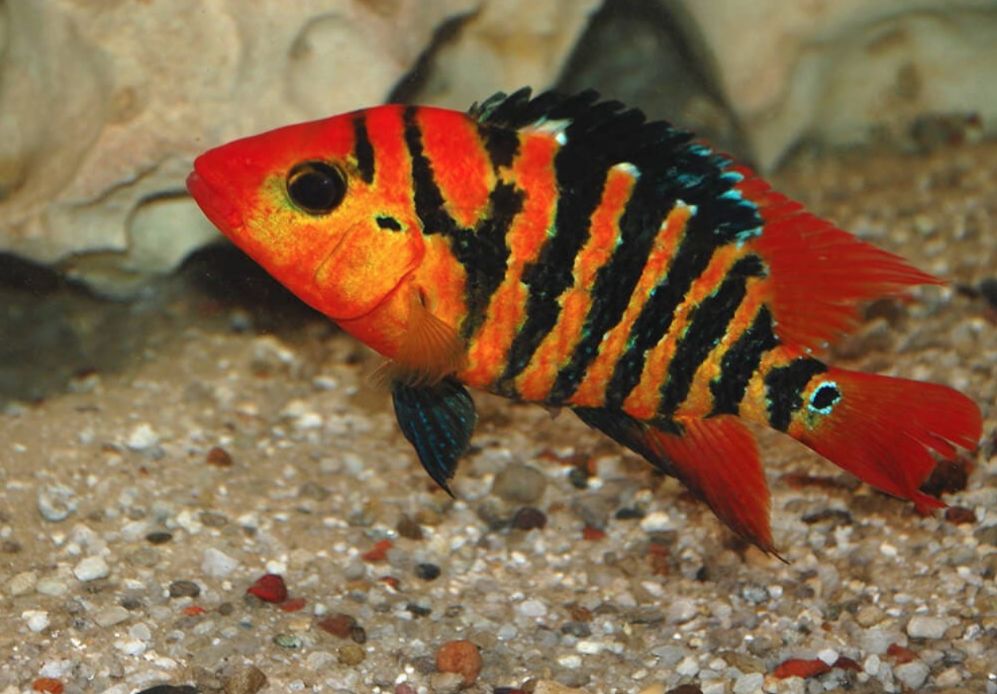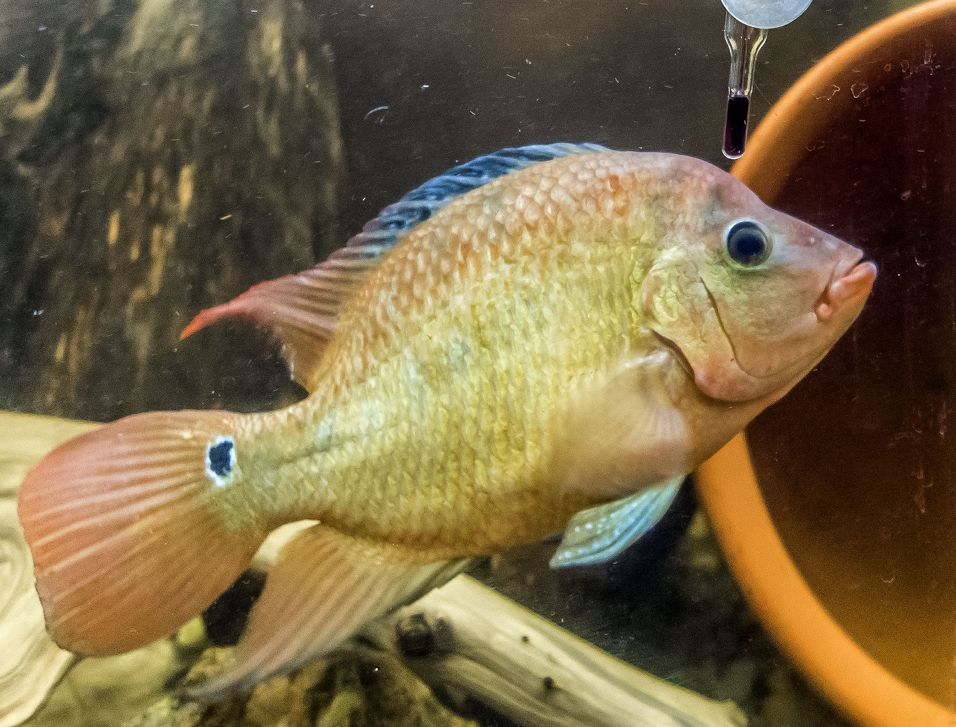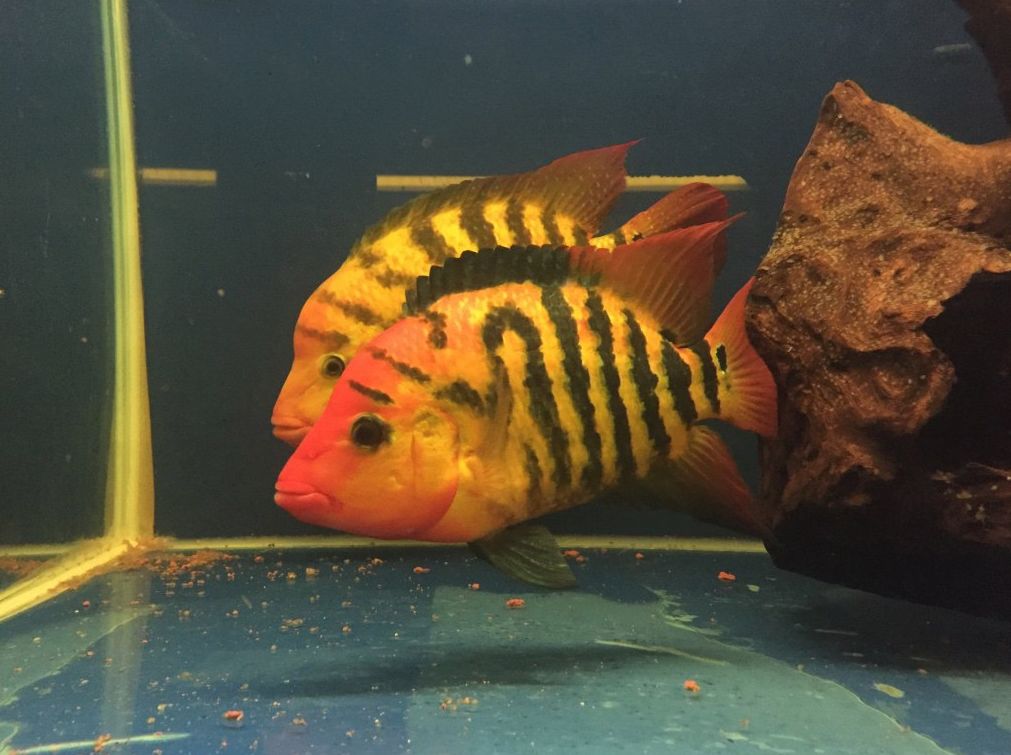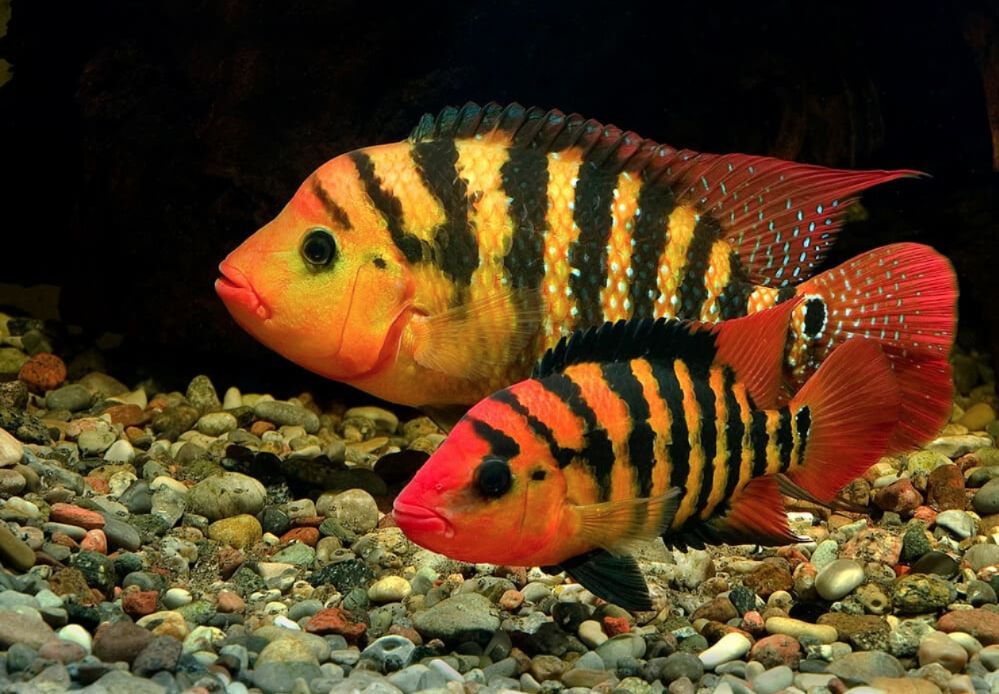Red terror cichlid (Cichlasoma festae) is a bright, large and territory dependent fish of Cichlidae family. Often the fish is kept in species tanks due to its temper. This fish is moderately difficult in terms of keeping. But this is one of the best fishes for those who want to have extremely clever, large, bright and aggressive fish in a tank.

Contents
Habitat in the wild
In the wild harlequin cichlid is encountered in waters located in the West of South America from Río Esmeraldas river (Ecuador) to Río Tumbes river basin (Peru). It also can be seen as invading species in Singapore waters.
It likes places with strong water flow and swims in the middle waters closer to the bottom, it hides in dentings and pits under snags where tree branches hang above the water. The red terror cichlid feeds mainly near the bottom with crustaceans, small fishes and plant food as well.
In the wild, these cichlids are often found in slow-moving or still waters, including rivers, streams, and lagoons. They prefer areas with rocky substrates, submerged tree roots, and aquatic vegetation. These natural features provide them with hiding spots, territorial boundaries, and potential spawning sites.
Cichlasoma festae is known to inhabit both clear and turbid waters, and they are often found in areas with moderate to dense vegetation along the shorelines. They are typically encountered in regions with a tropical climate and temperatures that range from around 22°C to 28°C (72°F to 82°F).
Description
Size
How big do red terror cichlids get? In the wild, they can grow up to 50 cm (20 inches) large and the females are up to 30 cm (12 inches) long. In aquariums, red terror cichlids can also reach a considerable size, and it’s not uncommon for well-cared-for individuals to grow to around 10 to 12 inches (25 to 30 cm) or more. However, it’s essential to note that the size of these fish can be influenced by various factors, including their environment, diet, and genetics.
Lifespan
The lifespan of a red terror cichlid can vary based on factors such as the quality of care, diet, and environmental conditions. In general, when kept in optimal conditions in a well-maintained aquarium, red terror cichlids can live for around 10 to 15 years or even longer in some cases.
Color
Females coloring is red with rows of vertical black stripes and small sparkling blue spots, the snout is orange-red. The male fish has turquoise green body with orange fins and blue spots on its tail.
| Characteristic | Description |
|---|---|
| Scientific Name | Parachromis festae |
| Common Names | Red Terror Cichlid, Harlequin cichlid, Festae cichlid, |
| Family | Cichlidae |
| Origin | Western Ecuador and Northern Peru, South America |
| Size | Up to 50 cm (20 inches) |
| Lifespan | 10 to 15 years or more in captivity |
| Coloration | Vibrant red-orange with some black markings |
| Behavior | Aggressive and territorial |
| Aquarium Size | At least 75 gallons (284 liters) for a single specimen |
| Water Parameters | pH: 6.5-8.0, Temperature: 72°F to 82°F (22°C to 28°C) |
| Diet | Omnivorous, feeds on both live and prepared foods |
| Tank Setup | Rocks, driftwood, and plants for hiding and territory |
| Breeding | Substrate spawner, both parents care for the fry |
| Compatibility | Best kept with larger, robust fish and similar species |
| Difficulty | Intermediate to advanced (due to aggression) |

Difficulties in keeping
This is a fish for experienced aquarists. In general it is undemanding in terms of keeping, though it is very large and highly territory dependent. It is critical to keep it alone in large species tanks.

Care and keeping in a tank
Tank size
Just like when keeping other large cichlid species, you’ll keep red terror cichlid successfully if you create tank conditions for it like those in the wild. And when we are speaking about very large and aggressive fish, it is also crucial to provide it with sufficient place to live, which makes it less aggressive and ensures that the fish grows large and healthy.
To keep a couple of red terror cichlids you’ll need a tank from 500 liters (110 gallons) capacity or twice larger, especially if you want to keep them with other fishes.
Tank decor
Harlequin cichlid like other species of its kind tends to ‘change’ the tank interior environment based on its own preferences. This process looks like digging bottom substrate all the time and digging out tank plants. Small pebbles or granite chipplings will do the best as tank bottom substrates.
It is a must to put stones on the tank bottom, they’ll help to divide the bottom area into several sections. Also you may use large stones to create caves and rock shelters, since they are a perfect place to hide for a cichlid that wants to stay alone for some time.
In different areas of the tank bottom you should put several stones or other objects with flat surface. They are necessary in case if fish starts to lay eggs in a community tank. It is recommended to use flower pots to put there tank plants, then dig them into the bottom substrate and decorate them.
Tank plants should be rather hardy, fast growing with strong roots. Thickly planted tank plans also serve as a good shelter for the fish.
Water parameters
These cichlids originate from running waters and that’s why they are sensitive to the presence of accumulated organic waste in the tank water; the fish also produces waste in large amount due to their protein diet.
To maintain high water quality you will need to put a powerful filter with efficient biological filtration and every week renew part of the tank water with the fresh one (20–30% from the total tank volume) as well as to clean the bottom substrate regularly.
This way you will reduce ammonia and nitrates content in the water since red terror cichlid produces a lot of waste and likes digging the bottom substrate all over the tank.
As for the tank water parameters, the red terror cichlid is not demanding in this respect – it can dwell at various water parameters. However, the following ones will suit the best: temperature 25-28 °C (77-82,4 °F), pH: 6.0 to 7.5, hardness from 4 to 18°dH.
Diet
Harlequin cichlid is a predator and that’s why live food and fish is a must in its diet. In the wild the fish feeds on crustaceans, mussels and small fishes.
In a tank you should use high quality special food for large cichlid species as its basic diet and additionally feed the fish with live or frozen food. Also you can feed it with live crustaceans or fish, for example, guppy, to stimulate its natural process of hunting.
But keep in mind that when using this kind of food there is a risk of infecting the tank, so it is crucial to feed red terror cichlids only with the fish that passed isolation period.
Tank mates
This is a territory dependent and aggressive fish species that completely proves one of its names – ‘red terror’. It is possible to keep it together only with enduring and strong fishes of similar size and temper. Other fish kinds or smaller tank mates will be haunted all the time or simply eaten.
Red terror cichlid is the same aggressive to its kind, that’s why it is desirable to keep only one adult fish species or a formed fish couple (male and female) in a tank.
It is possible to keep the fish in spacious tanks with the same large and quarrelsome fish species. For example, with flowerhorn, oscar fish, green terror, jaguar cichlid. Or with completely unlike species: sailfin pleco, common pleco, arowana.
Unfortunately, you can’t predict the outcome of such a company in advance, since much depends on the temper. There are some aquarists and their pets live quite peacefully and sometimes the fish end up dying or injured.
Gender differences: male vs female
Reproductive red terror cichlid females are brighter colored (they maintain their coloring) and they have more aggressive behavior. The males are much larger and as they grow their coloring fades. By the age of three years old the males have a large nuchal hump on their forehead.

Breeding
We have to mention that the red terror cichlid form couples as they grow older when keeping them in a large group. Future partners choose each other themselves and only they know how, after this they maintain the relationship for a long time.
Possibility to form a couple just by putting a male and female together is almost zero. The only thing you will get by doing so is death of one of the fish because one of them will constantly attack another. Unlike other aggressive species female is more aggressive than the male. It may beat the new male before she starts to spawn with him.
She even may kill the male if he appears to be not strong enough. The female red terror cichlid tends to be the first to check the male for strength. They interlock their jaws and try to see who is stronger.
If it turns out that the female is stronger than the male one, you’ll have to replace one of the partners. It is crucial that the male is stronger in the couple, only in this case the relationship will be harmonious and possibly it’ll lead to the offspring appearance in the nearest future.
You can trigger the spawning process by raising the water temperature to 26–28 °C, reducing water hardness to 10°, pH – 7,0 and renew the tank water up to twice a week. The female lays eggs on a flat stone cleaned by the male in advance. In general there are about 100–1000 eggs.
You should keep in mind that the number of eggs to a great extent depends on tank conditions and the maturity.The egg stage lasts about 3-4 days. The adult fish carry the juveniles into pits they dig in advance. In 4-5 days the juveniles start to swim and feed.
During the first days of their lives the juveniles may feed with slime produced with moisture glands of the male and female. If the couple was formed when the red terror cichlid were young and you keep it at ideal tank conditions, the juveniles may stay with them for two weeks since they hatch.
However, still it is better to keep the juveniles in a separate tank.
Moving the juveniles into a nursery tank should be done by means of a wide hose. The water should have the same parameters than those in the spawning tank where the juveniles hatched.
You can start feeding the red terror cichlid juveniles with brine shrimp nauplii. You should sort the juveniles as they grow according to their size and gradually start feeding them with larger sized food.
When the fish is 2 months old water parameters in the nursery tank should be slowly changed to be like those that are proper for the adult fish keeping. Juveniles body is gray colored with lateral stripes, but as they grow it changes to brighter orange-red coloring.